Parthian army and its characteristics
Although there are no accurate and complete documents about the composition and organization of the Parthian army like the Achaemenid army, but the description that the reliable Roman historians have mentioned of the bravery and agility and skill of the Parthian cavalry in shooting and according to the description of the events of the wars between Iran and Rome It turns out, it can be said that the Parthian kings owe their brilliant victories against the Romans to lightning maneuvers and bravery of this order, and the historical fame and honor of Iranian horsemen actually begins from this period.. So, there is no doubt that the main and main line of the Iranian army during the Parthian era was the cavalry part, and in addition to that, the infantry line and the Jamaz horsemen were also used.. According to the statements of Roman historians such as Plutarch, Justin, etc., the Iranian cavalry was divided into two privileged parts during the Parthian period.: Gun style rider. ۲- heavy gun rider
Gun style rider
This line was the factor of movement and maneuver and more for the execution of fast movements, extensive maneuvers, delaying operations, handling, discoveries, cover and fighting in their shooting to such an extent that they often quickly turned back on the saddle during the gallop and shot with a vengeance. With this description, their arrows were less likely to go wrong.
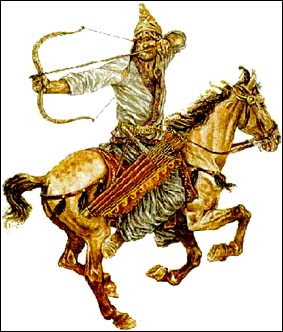
At the beginning of the battle, the cavalry units attacked the enemy from several sides and rained their arrows heavily on the enemy, even if the enemy tried to attack, they avoided engaging him and fighting hand-to-hand and went to war. And they ran away, and as soon as they chased the enemy for a while and exhausted him in every way, they retreated in front of him and gave their place to the cavalry of heavy weapons, and they defeated the enemy by delivering decisive blows. And they made a mess. According to the narrations of some historians, the work of the other light-armed riders was to raise dust so that the enemy could not recognize their talent or the direction of their retreat under the shelter of it..
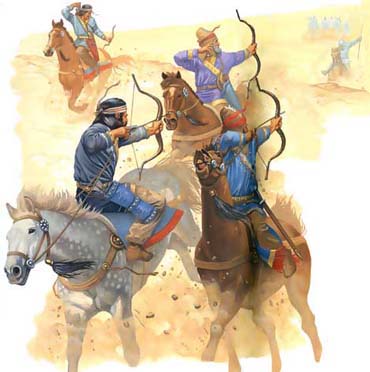
heavy gun rider
This line was the cause of close and hand-to-hand combat, and for this reason, these riders were completely drowned in the iron of Polad.. Their defensive weapon was a long leather jacket that reached up to the knees and iron pieces were sewn on it, their metal helmets protected the back of the neck and part of the face Their pants were made of leather and reached to their feet, and they covered their horses with saddles made of camel leather, which were sewn with pieces of iron in the shape of chicken feathers, and all these pieces were polished and shiny, and some of these riders had shields made of raw leather or metal. they had. Their offensive weapon was a very strong long spear that exceeded two meters in length, and the power of these horsemen was so strong that they often cut two Roman soldiers together with one blow.. They wore a short two-edged sword and a knife on their waists, which they used when fighting the enemy..
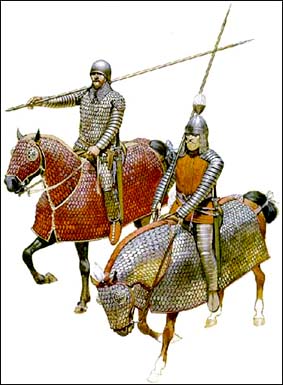
Infantry
In the army of the Parthian period, the number of foot soldiers was very small compared to the cavalry, and they were only used to protect the camps, protect fortresses and gates, and perform military services..
Jamaz horsemen (camel rider)
In some cases, including the battles of Ordvan V with the Romans, it has been seen that the Jamaz cavalry was used in the Parthian army and was actually part of the heavy cavalry, but in these battles, like the Romans, they threw small spiked bullets on the ground at the feet of the camels. They hurt and slow down their movement. Because of this, in the later periods, the Jamaz part was no longer used.
An army of guerrillas
From the writings of Roman historians, it is clear that apart from the garrisons of the capital or other important cities that were royal residences in different seasons, the guards of the forts and the important military gates of the Parthian armies were not assembled as a permanent army in certain centers and only during war. They were summoned and governed as guerillas. Most of the people of the army were nationals of Parthian leaders and elders and they themselves participated in the war. As Josten says, in the war between the Parthian general Soren and the Roman Crassus, 400 Parthian nobles participated and their horsemen numbered 50,000.. Plutarch says when describing Soren, a famous Iranian general of that period: "Soren alone could present ten thousand armed and equipped men from his subjects on the battlefield".
The life of soldiers
The soldiers of Parthia lived a very simple and contented life, and according to the custom of the tribes and the Illyrians, they often lived on the back of horses, and they were so strong in riding and enduring the hardships of war, heat, and thirst that they became a source of astonishment for the Romans.. The Parthians avoided fighting at night and stopped fighting as soon as it got dark and cut off contact with the enemy and camped far away from him, because on the one hand they were not used to trenching and strengthening their camp and on the other hand because Their horses were very interested, they knew it was necessary to give them rest at night.
The way of fighting
Because the Parthians did not know much about the technique of siege and fort building, even if in some wars they captured the Romans' siege tools and equipment, they destroyed them immediately.. There is no trace of sickle-shaped chariots and chariots of the Achaemenid period in the Parthian army because their combat methods and mounted operations did not require the use of chariots..
The Parthians were not very willing to fight in the winter season, and some Roman historians think that because their skill was more in shooting and in the winter season due to the humidity of the air, the strings of the bows became weak, so their arrows were useless.. But most of them are of the opinion that because it was impossible to provide fodder for large parts of the horse during the winter season, and the horses became weak and lame from a little fodder, therefore they avoided war even if possible in this season..
When attacking the enemy, the Parthian riders chanted and made noise and had small drums that made a loud noise by beating them..
At the time of peace negotiations, the custom of the Parthians was to open the strings of their bows and still approach the enemy.. In order to carry provisions, fodder, and war supplies, especially the large amount of arrows they carried, the Parthians had well-ordered trunks and used camels and chariots more..
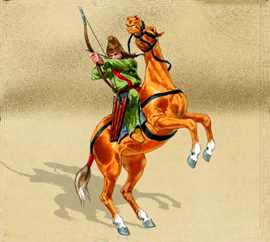
Military achievements
It was because of this skillful and powerful cavalry that the Parthians were able to stop the conquering and invincible legions of the Roman Empire on the banks of the Euphrates and the Tigris and destroyed the famous and proud Roman generals like Crassus in the battle of "Harran" and the forces of Antony, another Roman general, in little thing( Azerbaijan) Defeat them in such a way that the said general, by agreeing to a humiliating retreat, only saves his life from the clutches of Rashid Part's cavalry.. The Roman historian Justin writes in describing the bravery of the Parthian cavalry:
"One should look at the masculinity and bravery of the Parthians with amazement and admiration. Because of their bravery and warlikeness, the Parthians not only made the people they ruled subject to them, but also defeated the Roman government when it reached the peak of its power and attacked Iran three times with its best generals, and as a result it turned out that the Parthians They are the only people who are not only equal to the Romans, but also considered the conquerors of the Roman army..
• • • • • • • • • • • • • • • • • • • • • • • • • • • • • • • • • • • • • • • • • • • • • • • • •
Click on the link below to download the Parthian Army book


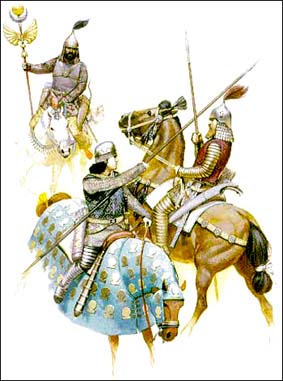

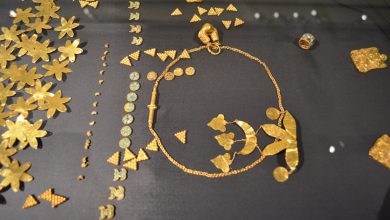
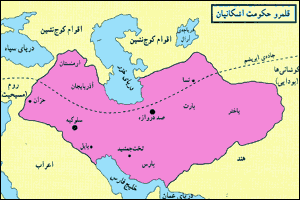
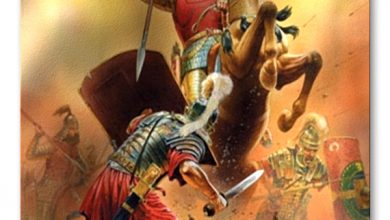
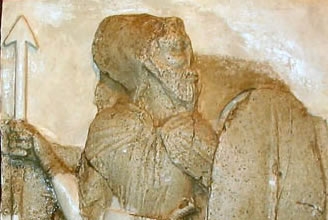
I had a request::
Bahman's place is really magical in this empty site!
Why?!
درود
here you are:
https://parsiandej.ir/%D8%A8%D9%87%D9%85%D9%86-%D8%AC%D8%A7%D8%AF%D9%88%DB%8C%D9%87/
Justi’s not!